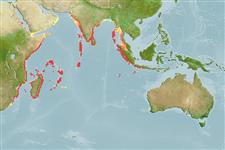>
Mulliformes (Goatfishes) >
Mullidae (Goatfishes)
Etymology: Parupeneus: Latin, parum, parvum = small + Peneus, the name of a river.
More on author: Lacepède.
Environment: milieu / climate zone / depth range / distribution range
Sinh thái học
Biển Cùng sống ở rạn san hô; Mức độ sâu 0 - 80 m (Ref. 1602). Tropical; 24°N - 33°S, 28°E - 112°E
Indian Ocean: Oman and East Africa south to South Africa and east to Christmas Island and Java, Indonesia.
Included in the Parupeneus trifasciatus complex are: Parupeneus trifasciatus from the Indian Ocean; Parupeneus crassilabris from eastern Indian Ocean and the western Pacific, east to Fiji, Tonga, and the Caroline Islands; and Parupeneus insularis from the more eastern islands of Oceania.
Bộ gần gũi / Khối lượng (Trọng lượng) / Age
Maturity: Lm ? range ? - ? cm
Max length : 35.0 cm TL con đực/không giới tính; (Ref. 30573); common length : 27.0 cm TL con đực/không giới tính; (Ref. 30573); Khối lượng cực đại được công bố: 656.00 g (Ref. 125599)
Các tia vây lưng cứng (tổng cộng): 8; Các vây lưng mềm (tổng cộng): 9; Tia cứng vây hậu môn 1; Tia mềm vây hậu môn: 7.
This occasionally schooling species inhabits lagoon and seaward reefs: juveniles on reef flats, adults tend to occur around rocky or coralline areas of high vertical relief. Feeds on crustaceans at daytime and on fishes and crab larvae at night. Also feeds on worms (Ref. 6113). Occurs in 3 color forms. The Indian Ocean form has 2 sharply defined wedge-shaped bars become narrower and sometimes end on the belly. The Indo-Australian form has 3 very distinct dark patches and rows of yellow spots on the sides. The Pacific Plate form has 2 wide bars that extend to the belly (Ref. 37816). Minimum depth reported taken from Ref. 128797.
Life cycle and mating behavior
Chín muồi sinh dục | Sự tái sinh sản | Đẻ trứng | Các trứng | Sự sinh sản | Ấu trùng
Randall, J.E. and R.F. Myers, 2002. Parupeneus insularis, a new central pacific species of goatfish (Perciformes:Mullidae) of the P. trifasciatus complex. Zool. Stud. 41(4):431-440. (Ref. 45589)
IUCN Red List Status (Ref. 130435)
Threat to humans
Harmless
Human uses
Các nghề cá: Tính thương mại
Các công cụ
Special reports
Download XML
Các nguồn internet
Estimates based on models
Preferred temperature (Ref.
123201): 23.6 - 29, mean 27.8 °C (based on 1364 cells).
Phylogenetic diversity index (Ref.
82804): PD
50 = 0.5000 [Uniqueness, from 0.5 = low to 2.0 = high].
Bayesian length-weight: a=0.00813 (0.00535 - 0.01235), b=3.18 (3.06 - 3.30), in cm total length, based on LWR estimates for this species & Genus-body shape (Ref.
93245).
Mức dinh dưỡng (Ref.
69278): 3.5 ±0.50 se; based on food items.
Thích nghi nhanh (Ref.
120179): Trung bình, thời gian nhân đôi của chủng quần tối thiểu là 1.4 - 4.4 năm (Preliminary K or Fecundity.).
Fishing Vulnerability (Ref.
59153): Low vulnerability (25 of 100).
Nutrients (Ref.
124155): Calcium = 33.2 [16.8, 74.0] mg/100g; Iron = 0.307 [0.155, 0.679] mg/100g; Protein = 17.9 [14.5, 20.9] %; Omega3 = 0.128 [0.073, 0.231] g/100g; Selenium = 56 [27, 128] μg/100g; VitaminA = 195 [39, 810] μg/100g; Zinc = 0.531 [0.319, 1.009] mg/100g (wet weight); based on
nutrient studies.
